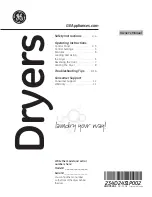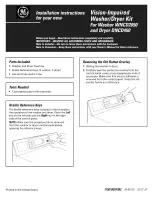
5
CYCLE GUIDE — SENSOR DRY CYCLES
Cotton/Linen
Heavy cottons and denims
More Dry
Normal
Cottons and linens
Normal
Normal
Synthetics
White and colorfast permanent press
Normal
Low
White and colorfast items that require ironing
Iron Dry
Low
Polyester/acrylic blends, rayon, acetate
Damp Dry
Low
Washable silk and nylon
Damp Dry
Low
Items to dry:
Cycle:
Temperature
Setting:
Use Sensor Dry Cycles for better fabric care and energy savings
When you are using the GentleBreeze
™
Drying System with IntelliDry
®
Sensor, two metal strips located in the dryer determine the
dryness of the load. When there is moisture left in the clothes, the dryer will continue to run. As clothes begin to dry, the amount of
water left in the clothes decreases, and the timer advances through the remainder of the cycle. When the selected dryness level is
reached, the dryer goes into a cool-down period.
Sensor dry cycles may be used for most loads. Sensor dry cycles give the best drying results in the shortest time. Drying time varies
according to the type of fabric, size of the load, and dryness setting.
After drying a load, check the dryness.
n
If the load is drier than you like, select a setting closer to Iron Dry the next time you dry a similar load.
n
If a load is not as dry as you like, complete drying using a Timed cycle. Select a setting closer to More Dry the next time you dry
a similar load.
CYCLE GUIDE — TIMED DRY CYCLES
IMPORTANT:
It is not recommended drying heavyweight items in Timed Dry cycle.
Heavyweight items can be dried using Automatic cycles.
Use this cycle to get up to 60 minutes of heated drying time or to complete drying if items are still damp after the automatic cycle.
Timed Dry is useful for lightweight items, such as lingerie, blouses, and knits that require a short drying time.
White and colorfast permanent press
40
Low
White and colorfast items that require ironing
40
Low
Polyester/acrylic blends, rayon, acetate
40
Low
Washable silk and nylon
40
Low
Items to dry:
Time
(Minutes):
Temperature
Setting:






































